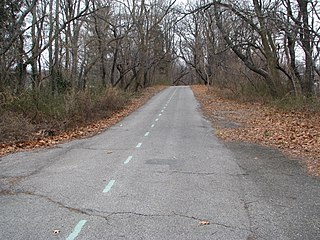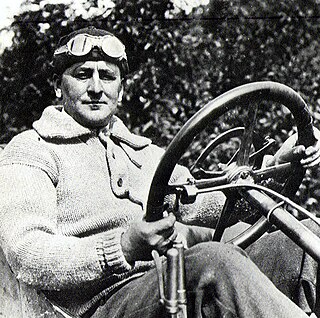
The Long Island Motor Parkway, also known as the Vanderbilt Parkway, Vanderbilt Motor Parkway, or Motor Parkway, was a roadway on Long Island, New York, in the United States. It was the first roadway designed for automobile use only. The parkway was privately built by William Kissam Vanderbilt II with overpasses and bridges to remove most intersections. It officially opened on October 10, 1908. It closed in 1938 when it was taken over by the state of New York in lieu of back taxes. Parts of the parkway survive today, used as sections of other roadways or as a bicycle trail.

William Kissam Vanderbilt I was an American heir, businessman, philanthropist and horsebreeder. Born into the Vanderbilt family, he managed his family's railroad investments.

Raymond Pierre Sommer was a French motor racing driver. He raced both before and after WWII with some success, particularly in endurance racing. He won the 24 Hours of Le Mans endurance race in both 1932 and 1933, and although he did not reach the finishing line in any subsequent appearance at the Le Mans, he did lead each event until 1938. Sommer was also competitive at the highest level in Grand Prix motor racing, but did not win a race. He won the French Grand Prix in 1936, but the event that year was run as a sports car race. After racing resumed in the late 1940s, Sommer again won a number of sports car and minor Grand Prix events, and finished in fourth place in the 1950 Monaco Grand Prix, the second round of the newly-instituted Formula One World Drivers' Championship. He was killed toward the end of 1950, when his car overturned during a race at the Circuit de Cadours.
Clément-Bayard, Bayard-Clément, was a French manufacturer of automobiles, aeroplanes and airships founded in 1903 by entrepreneur Gustave Adolphe Clément. Clément obtained consent from the Conseil d'Etat to change his name to that of his business in 1909. The extra name celebrated the Chevalier Pierre Terrail, seigneur de Bayard who saved the town of Mézières in 1521. A statue of the Chevalier stood in front of Clément's Mézières factory, and the image was incorporated into the company logo.

Ferenc Szisz, was a Hungarian racing driver and the winner of the first Grand Prix motor racing event on a Renault Grand Prix 90CV on 26 June, 1906.

William Kissam Vanderbilt II was an American motor racing enthusiast and yachtsman, and a member of the prominent Vanderbilt family.

The Vanderbilt Cup was the first major trophy in American auto racing.

Harry Payne Whitney was an American businessman, thoroughbred horse breeder, and member of the prominent Whitney family.

Louis Auguste Wagner was a French Grand Prix driver who won the first ever United States and British Grands Prix. Wagner was also a pioneer aviator.

Harold Fletcher Grant was an American auto racing driver.
Peter Helck was an American illustrator who specialized in depicting racecars. He estimated that he had produced more than 600 sketches, drawings and paintings during his career.
The 1906 Grand Prix season is regarded as the first Grand Prix racing season. It marked the advent of two iconic races: The French Grand Prix and the Targa Florio.

Joseph Tracy was an Irish-born American racing driver.

The 1906 Vanderbilt Elimination Race was a motor race run to decide which five cars would represent the United States in the international 1906 Vanderbilt Cup.

Tom Cooper was an American cyclist and early automobile racing driver. He is best known for his rivalry with cyclist Major Taylor, as well as his later work with Henry Ford and Barney Oldfield.
The 1910 AAA Championship Car season consisted of 19 races, beginning in Atlanta, Georgia on May 5 and concluding in Long Island, New York on October 1. AAA did not award points towards a National Championship during the 1910 season, and did not declare a National Champion.
The AAA Contest Board was the motorsports arm of the American Automobile Association. The contest board sanctioned automobile races from 1904 until 1955, establishing American Championship car racing. Modern-day IndyCar racing traces its roots directly to these AAA events.

Albert Clément was a French motor racing driver. In 1904 he won the II Ardennes Cup race and finished third in the III Ardennes Cup race at Bastogne. He also finished second in the Vanderbilt Cup on Long Island. In 1906 he finished third in the inaugural French Grand Prix and 4th in the Vanderbilt Cup. All his driving was in the Clément-Bayard factory team that was owned by his father Adolphe Clément-Bayard.

Arthur Rayner Pardington was the chief engineer and 2nd Vice President of the Long Island Motor Parkway, Inc., which oversaw the building and development of the parkway. He was also the vice president and general manager of the Lincoln Highway Association and organized the Long Island Automobile Club.

Hubert Le Blon was a French automobilist and pioneer aviator. He drove a steam-powered Gardner-Serpollet motorcar in the early 1900s, and then switched to Hotchkiss for both the world's first Grand Prix at Le Mans in France and the inaugural Targa Florio in Sicily. At the Vanderbilt Cup races on Long Island he competed for the US driving a Thomas.















